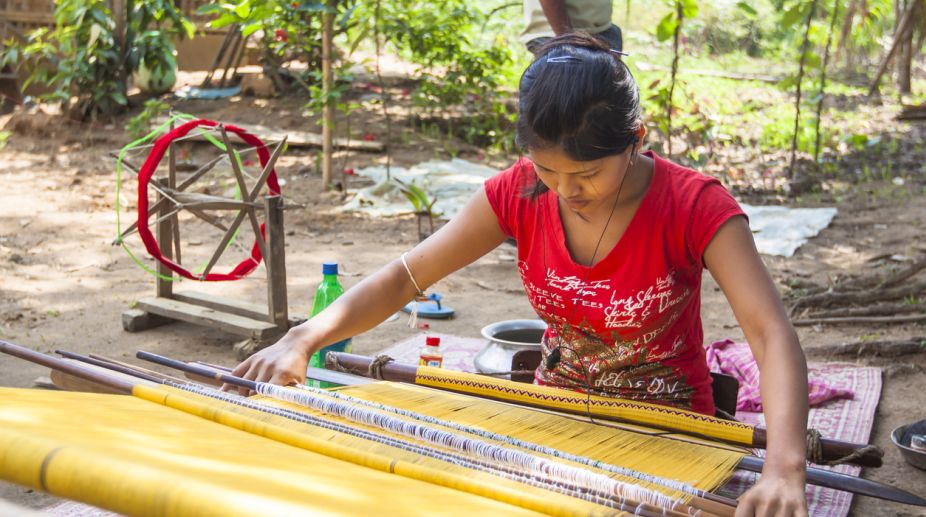Amid the challenges of producing quality products in large quantities and market competition, weaving may take a back seat in the North-east but yet it is one of the most vital sources of livelihoods and income generation for thousands of people, particularly in rural areas.
Next to agriculture, the handloom industry continues be the second largest employment generator in the region. At the heart of this important tradition and economy are women weavers. Though invisible, weaving and weavers keep the domestic economy going. On 9 August, National Handloom Day, Union minister for textiles, Ajay Tamta said that this year the Centre was taking various initiatives for the welfare of handloom weavers.
Presiding over the main event of the Third Handloom Day celebrations in Guwahati, the minister said he not only appreciated but also saluted the handloom weavers for their commitment, dedication and skills.
They should be able to earn due value for their produce, and that the government was working in this direction. Assam chief minister, Sarbananda Sonowal said about 50 per cent of weaver population of India lived in the North-east and most of them were women. In 2015, Prime Minister Narendra Modi asked people to help promote handloom and handicraft and thus preserve the great tradition of weaving in the country.
In his inaugural speech at the first national handloom day in Chennai, the Prime Minister noted that handlooms could be a tool to fight poverty, just as swadeshi was a tool in the struggle for freedom. He also noted that India, whose products were once in demand across all continents, had not been able to market its handloom products in recent times.
True to what the Prime Minister stated, a peek into the report on handloom and handicrafts in the Northeast does not give an encouraging picture. The annual report of the NE Handloom and Handicraft Corporation for 2015-16 says that the gross sale turnover of the corporation during the financial year 2015-16 was Rs 113.11 lakh and the net loss was Rs 195.86 lakh.
The authorised share capital of the corporation was Rs 8.50 crore, as of March 2016. The NEHHC record showed losses over the years. Report of the financial performance over a period of five years showed no improvement.
Between the financial years 2011-2012 there was the turnover of Rs1,681.77 lakh with a loss of Rs 150.71 lakh, Between 2012- 2013 there was a turnover of Rs 1,299.27 lakh with a loss of Rs 149.58 lakh; in 2013-14 the turnover was Rs 1,239.22 lakh and loss of Rs 439.76 lakh. The NEHHC report observed that employees have low morale due to non-revision of the pay scales.
There was a lack of professionals in strategic areas of marketing and finance. The sector was highly fragmented, unstructured and there was individualised production system with no product certification and standardisation.
There were very limited institutionalised sales and showrooms, the report stated. Meanwhile the region, as the gateway to Southeast Asia, could have been promoted and made into an economic gateway. But for handloom weavers and craftsmen this was something that did not happen. The NEHHC report observed that there was increasing threats from Asian countries, with better quality, packaging, innovation and technology.
This inflow of various products ranging from household items like electronics, clothes, and food products of other Asian countries, particularly South-east Asia, flooded the markets in the North-east. Local products were obviously not in a position to compete with these readily available, attractive and cheap products.
Now, even as handloom weavers across the country are facing challenges and stiff competition, the GST Act has further created uncertainty for millions of weavers across the country. Though the North-east may pay less tax under the GST Act, it is a cause for worry for handloom weavers and handicraft artisans in other parts of the country.
The Federation of Handloom Organisation recently wrote to the Prime Minister and finance minister Arun Jaitley urging for GST exemption on handmade products. The federation stated that the GST Act was a direct threat to artisans engaged in non-machine production.
The absence of the word “hand” in the list of goods and services was indicative of the dismissal of any recognition of handmade in the GST. In the textile sector, after the GST, the distinction between hand woven and machine woven has been removed and there is a five to 10 per cent increase in prices in handlooms after the GST came into force.
Tax on handlooms will discourage even existing customers and further reduce the demand for these products, already facing competition from powerloom imitations, the petition stated. The compliance for GST demands the pre-existence of IT infrastructure, digital literacy, and access to experts like chartered accountants for uploading GST forms every month.
All these call for resources, both human and financial, which will be impossible for small producers. They are also an additional financial burden. It is imperative to exempt products made by handloom and handicraft artisans from GST to protect rural livelihoods, said the petition. It has also been reported that weavers in Andhra Pradesh and Telangana, due to GST tax on cotton yarn, had spiked the price of handloom products.
The National Handloom Development Corporation, from where weavers get their raw materials, has refused to supply yarn to handloom societies that do not have a registered GST number. The handloom sector is reported to be the worst hit by the GST. While there has been talk of promoting handloom products and preserving a great tradition, weavers are caught in the web of open market, technology and competition with policies such as the new GST Act further adding to their woes.
Unless there is political will to tackle the situation, the sector is sure to face major challenges in the near future.
(The writer is a freelance contributor based in Imphal)












